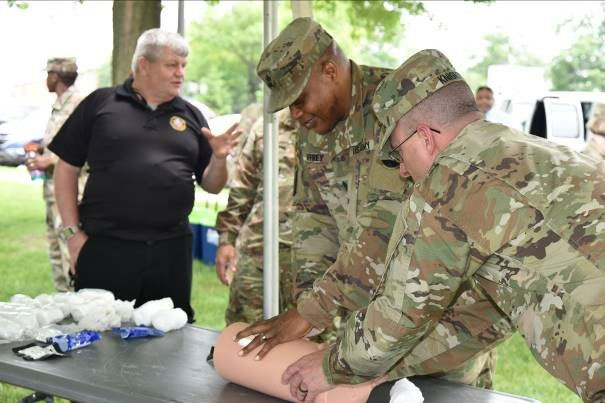"Stop the Bleed" Event to Preach Vigilance, Teach Life Saving Techniques

The U.S. Army Medical Research and Development Command will hold its second STOP THE BLEED® awareness event at Fort Detrick on May 19. The event, which will take place on Blue and Gray Field, is designed to draw attention to the mission of the STOP THE BLEED® program, a public awareness campaign created to teach the American public how to respond to instances of traumatic bleeding in everyday situations.
Specifically, the event will feature lessons on wound packing and proper tourniquet application technique from USAMRDC Service Members and medical experts.
"The program itself is, in many ways, a translation of the lessons that the U.S. Department of Defense learned from the battlefield," said Capt. Travis Polk, director of USAMRDC's Combat Casualty Care Research Program. "We've taught many thousands around the country – and around the world, too – to apply tourniquets and to stop bleeding in other ways by using pressure and wound-packing, and I think it's certainly made a difference."
The STOP THE BLEED® campaign was initially developed at CCCRP in 2015 as part of a cooperative effort with the U.S. National Security Council, which was at the time seeking a way to build national resiliency in the wake of mass trauma incidents at Sandy Hook Elementary School (2012) and the Boston Marathon (2013). A key tenet of the campaign is its reliance on the use of tourniquets, modern versions of which have been both developed by the U.S. military and used by Warfighters in innumerable combat scenarios.
The campaign was founded on the fact that, in many cases, death from blood loss is preventable. By encouraging the American public to learn proper bleeding control techniques – and in doing so possibly suppressing a wound and preventing excess blood loss until professionals arrive – many potential large and small-scale accidents can be prevented. For perspective, while it takes on average at least seven minutes for emergency medical service personnel to arrive at any given scene, experts state that it can take less than five minutes to die from severe bleeding.
"We're excited for this year's National Stop the Bleed Day on May 19," said Patrick O'Neill, Executive Director of the Stop the Bleed Project, a nonprofit entity dedicated to expanding the program's reach and impact via such tools as class registration drives, college scholarship programs and a variety of social media marketing initiatives. "We've added new activities so that anyone can participate. We're already seeing a lot more activity as the day approaches, now that effects of the pandemic are lessening."

Since its launch, the STOP THE BLEED® campaign has been licensed to more than 460 public and private entities across the globe, a number which includes partnerships with various U.S. state governments, hospital systems, medical supply manufacturers, community groups, police and fire departments and professional sports teams, among other organizations.
"I think everyone that we teach it to is really excited to learn it, and sees the applicability and realizes that bad things can happen to anyone, and everyone wants to be prepared for when those things take place," said Polk, a trauma surgeon by trade. "What I think has been most exciting is watching Stop the Bleed kits show up in public spaces, and also watching bleeding control tenets be incorporated into first aid programs – all of which ensures the program is exposed to larger and larger audiences."
The USAMRDC STOP THE BLEED® event will coincide with National Stop the Bleed Day. USAMRDC's live, in-person sessions will take place at 10 a.m. and 1 p.m. To sign up for a session, visit the sign up page.
To access virtual STOP THE BLEED® training sessions developed by the American College of Surgeons, a key campaign partner, visit here. For more information about the campaign itself and the many ways to get involved, go to stopthebleedproject.org.














